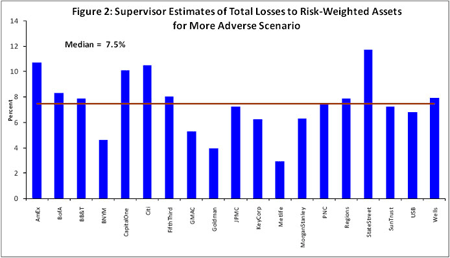From the Fed: The results of a comprehensive, forward-looking assessment of the financial conditions of the nation’s 19 largest bank holding companies (BHCs) by the federal bank supervisory agencies were released on Thursday.
The exercise–conducted by the Federal Reserve, the Office of the Comptroller of the Currency, and the Federal Deposit Insurance Corporation–was conducted so that supervisors could determine the capital buffers sufficient for the 19 BHCs to withstand losses and sustain lending–even if the economic downturn is more severe than is currently anticipated. In a detailed summary of the results of the Supervisory Capital Assessment Program (SCAP), the supervisors identified the potential losses, resources available to absorb losses, and resulting capital buffer needed for the 19 participating BHCs.
The SCAP is a complement to the Treasury’s Capital Assistance Program (CAP), which makes capital available to financial institutions as a bridge to private capital in the future. Together, these programs play a critical role in ensuring that the U.S. banking sector will be in a position of strength.
Click for The Supervisory Capital Assessment Program: Overview of Results
The results of the SCAP suggest that if the economy were to track the more adverse scenario, losses at the 19 firms during 2009 and 2010 could be $600 billion. The bulk of the estimated losses –approximately $455 billion – come from losses on the BHCs’ accrual loan portfolios, particularly from residential mortgages and other consumer‐related loans. The estimated two‐year cumulative losses on total loans under the more adverse scenario is 9.1 percent at the 19 participating BHCs; for comparison, this two‐year rate is higher than during the historical peak loss years of the 1930s. Estimated possible losses from trading‐related exposures and securities held in investment portfolios totaled $135 billion. In combination with the losses already recognized by these firms since mid‐2007, largely from chargeoffs and write‐downs on the values of securities, the SCAP results suggest financial crisis‐related losses at these firms, if the economy were to follow the more adverse scenario, could total nearly $950 billion by the end of 2010.
After taking account of losses, revenues and reserve build requirements, in the aggregate, these firms need to add $185 billion to capital buffers to reach the target SCAP capital buffer at the end of 2010 under the more adverse scenario. There are two important things to note about this estimate. First, the $185 billion accrues to 10 of the 19 firms, meaning 9 of the 19 firms already have capital buffers sufficient to get through the adverse scenario in excess of 6 percent Tier 1 capital and 4 percent Tier 1 Common capital. Second, the vast majority of this $185 billion comes from a shortfall in Tier 1 Common capital in the more adverse scenario, with virtually no shortfall in overall Tier 1 capital. This result means that while nearly all the firms have sufficient Tier 1 capital to absorb the unusually high losses of the more adverse scenario and still end 2010 with a Tier 1 risk‐based ratio in excess of 6 percent, 10 of these firms had capital structures that are too strongly tilted toward capital other than common equity. Thus, each of the 10 firms needing to augment their capital as a result of this exercise must do so by increasing their Tier 1 Common capital.
Graph: The Fed


Leave a Reply